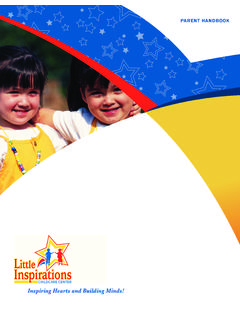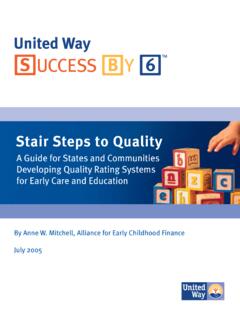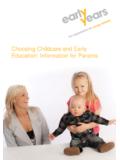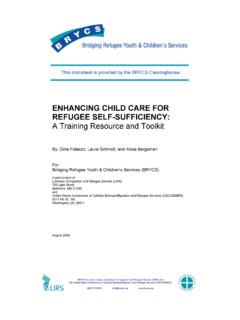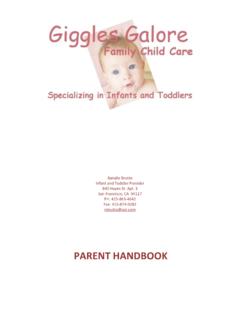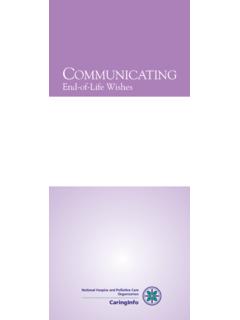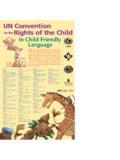Transcription of CHECK IT OUT: CHOOSING QUALITY CHILD CARE …
1 CHECK IT OUT: CHOOSING QUALITY . CHILD care AND PRESCHOOL. CHOOSING a CHILD care setting for your infant, toddler or preschooler is a big decision. QUALITY is one of the most important factors to consider, as research shows that QUALITY early learning settings QUALITY First, a signature program of help children develop skills that are crucial to their success now First Things First, partners with CHILD and once they enter school. But QUALITY is not always easy to spot. care and preschool providers across This checklist will help you recognize the key elements of QUALITY Arizona to improve the QUALITY of early learning for kids birth to 5. and make a more informed decision when considering a CHILD care Learn more at or preschool setting for your CHILD . AT YOUR VISIT: QUESTIONS TO ASK. Do you have a parent handbook?
2 How does the program deal with children with QUALITY programs should offer you a copy. challenging behavior? QUALITY programs have steps in place to prevent disruptions, What are the qualifications of the director and teachers? communicate with the CHILD , redirect the CHILD , and communi- How long have they been working with children? cate with the family. Time out is not effective in dealing with Experience working with infants, toddlers and preschoolers as disruptive children. well as training or college coursework in early childhood devel- opment and education lead to QUALITY adult/ CHILD interactions. Continue to the At Your Visit: Things to Look For Checklist How do you keep families informed about your program and their children's progress? NOTES. QUALITY centers will post lesson plans, send parents information such as a newsletter, host regular parent/teacher conferences and keep you informed about your CHILD 's activities.
3 What is your ratio of teachers to children? Maximum group size? These determine the level of care and attention your CHILD may receive. QUALITY programs have smaller teacher/ CHILD ratios and limit group sizes. Preferred Age of Children Teacher/ CHILD Ratio Birth-12 months 1:5 or less WANT FREE, CUSTOMIZED ASSISTANCE? 12-24 months 1:6 or less CHILD care Resource and Referral is a 2 year olds 1:8 or less statewide program that helps Arizona 3 year olds 1:12 or less families find CHILD care . Free, customized 4-5 year olds 1:13 or less referrals are available by phone, in In mixed-age group settings, CHECK these guidelines by the age person or online. To learn more, visit of the youngest CHILD in the group. or call 1-800-308-9000. AT YOUR VISIT: THINGS TO LOOK FOR CLASSROOM ENVIRONMENT. Is there ample space and materials to encourage play and POSITIVE, NURTURING TEACHER/ CHILD INTERACTIONS learning within the children's reach, including: Does the teacher make eye contact with the children, smile Books, books and more books and listen without interrupting?
4 Blocks and puzzles Is the teacher at eye level with the kids when they are interacting? Pretend play area with puppets, costumes, etc. Is the teacher interacting with children during activity times Art /writing materials and musical instruments indoors and outdoors? Textured materials, such as sand and water Do you hear the kids talking more than the teacher? CHILD Science materials, like plants, funnels, voices should dominate. magnifying glasses, etc. Does the teacher ask the children questions where they can OUTDOOR ENVIRONMENT. give more than a yes/no answer? Is there an outdoor play area, with shade, that is used daily? Are the children supervised at all times? Children should never be left alone and should always be within sight and Are items from the classroom brought outdoors sound of teachers. to be played with?
5 CARING FOR INFANTS Are the adults actively engaged with the kids at play? Are babies placed on their backs to sleep? Do babies spend part of their play time on their tummies? Do caregivers respond promptly to crying babies? AFTER YOUR VISIT: QUESTIONS TO ASK. Are babies held while being fed? YOUR CHILD . POSITIVE CHILD / CHILD INTERACTIONS Trust your instincts and also your CHILD 's reactions to the Are kids playing either together or side-by-side? teachers and environment. Are children encouraged to work together to resolve Do you think you would like to go play there? differences or conflicts? What did you like best about the classroom? Do kids move freely from activity to activity? What did you like best about the teacher? NOTES. 2014 First Things First Learn more at 2013 First Things First.
